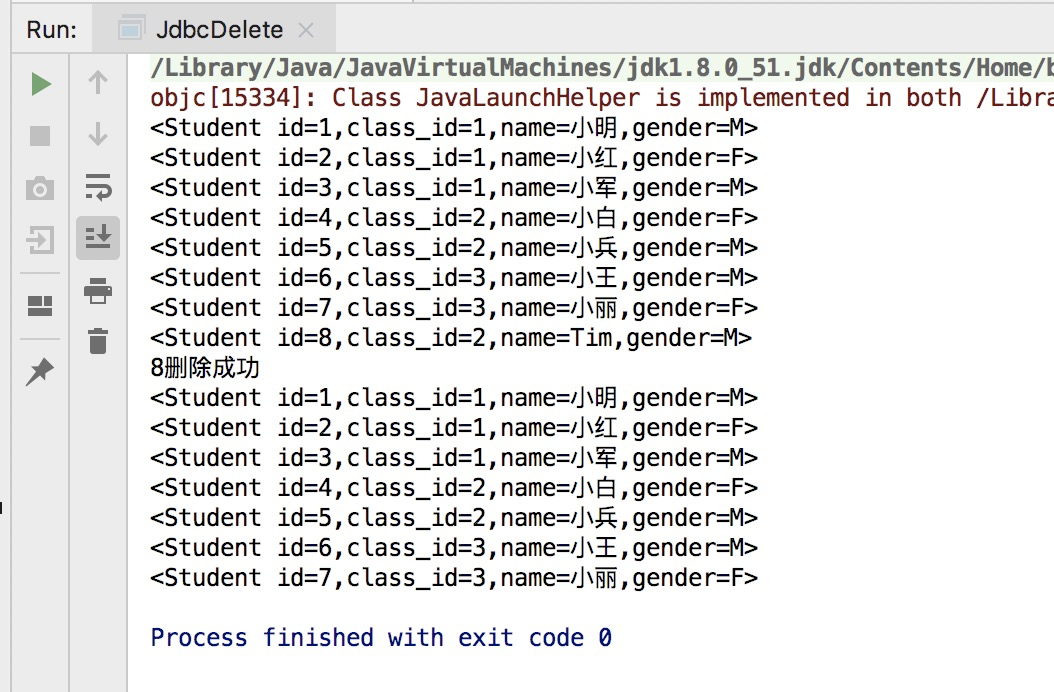廖雪峰Java15JDBC编程-3JDBC接口-3JDBC更新
使用update语句的时候,需要通过JDBC实现update语句的执行,这个时候仍然通过PreparedStatement对象来使用,直接传入update语句,然后通过setObject传入占位符的值,最后通过executeUpdate()就可以执行这个update语句。 executeUpdate()返回值是int,代表符合条件的记录数量。
## 1. update ```#java //update try(Connection conn = DriverManager.getConnection(JDBC_URL, JDBC_USER, JDBC_PASSWORD)){ try(PreparedStatement ps = conn.prepareStatement("update students set name=? where id=?")){ ps.setObject(1, "Bob"); ps.setObject(2, 999); ps.executeUpdate(); } } ``` ### 1.1 update修改示例 JdbcUpdate.java ```#java package com.feiyangedu.sample.pop3;import java.sql.*;
import java.util.ArrayList;
import java.util.List;
public class JdbcUpdate {
static final String JDBC_URL = "jdbc:mysql://localhost:13306/test0828?useSSL=false&characterEncoding=utf8&serverTimeZone=UTC";
static final String JDBC_USER="root";
static final String JDBC_PASSWORD = "123456";
public static void main(String[] args) throws SQLException{
List<Student> students = getAllStudents();
for(Student student:students){
System.out.println(student);
}
Student std = students.get(0);
std.classId = new Long(2);
std.name = "Alice";
std.gender = "F";
update(std);
System.out.println("--变更后--");
students = getAllStudents();
for(Student student:students){
System.out.println(student);
}
}
static void update(Student std) throws SQLException{
try(Connection conn = getConnection()){
try(PreparedStatement ps = conn.prepareStatement("update students set class_id=?,name=?,gender=? where id=?")){
ps.setObject(1, std.classId);
ps.setObject(2, std.name);
ps.setObject(3, std.gender);
ps.setObject(4, std.id);
int n = ps.executeUpdate();
System.out.println(n+"条记录发生变更.");
}
}
}
static List<Student> getAllStudents() throws SQLException{
try(Connection conn = getConnection()){
try(PreparedStatement ps = conn.prepareStatement("select * from students")){
ResultSet rs = ps.executeQuery();
List<Student> list = new ArrayList<>();
while(rs.next()){
Long id = rs.getLong("id");
Long classId = rs.getLong("class_id");
String name = rs.getString("name");
String gender = rs.getString("gender");
Student std = new Student(id,classId,name,gender);
list.add(std);
}
return list;
}
}
}
static Connection getConnection() throws SQLException {
return DriverManager.getConnection(JDBC_URL,JDBC_USER,JDBC_PASSWORD);
}
}
<img src="https://img2018.cnblogs.com/blog/1418970/201909/1418970-20190901102130426-1636009720.png" width="500" />
## 2. delete语句是一样的
```#java
try(Connection conn = DriverManager.getConnection(JDBC_URL, JDBC_USER, JDBC_PASSWORD)){
try(PreparedStatement ps = conn.prepareStatement("delete from student where id=?")){
ps.setObject(1, 999);
int n = ps.executeUpdate(); //返回结果为删除记录的数量
}
}
2.1 delete示例JdbcDelete.java
package com.feiyangedu.sample.pop3;
import java.sql.*;
import java.util.ArrayList;
import java.util.List;
public class JdbcDelete {
static final String JDBC_URL = "jdbc:mysql://localhost:13306/test0828?useSSL=false&characterEncoding=utf8&serverTimeZone=UTC";
static final String JDBC_USER="root";
static final String JDBC_PASSWORD = "123456";
public static void main(String[] args) throws SQLException{
List<Student> students = getAllStudents();
for(Student student:students){
System.out.println(student);
}
long studentId = students.get(students.size()-1).id; //查找最后1条记录的id
delete(studentId);
System.out.println(studentId+"删除成功");
students = getAllStudents();
for(Student student:students){
System.out.println(student);
}
}
static void delete(long studentId) throws SQLException{
try(Connection conn = getConnection()){
try(PreparedStatement ps = conn.prepareStatement("delete from students where id=?")){
ps.setObject(1, studentId);
ps.executeUpdate();
}
}
}
static List<Student> getAllStudents() throws SQLException {
try(Connection conn = getConnection()){
try(PreparedStatement ps = conn.prepareStatement("select * from students")){
ResultSet rs = ps.executeQuery();
List<Student> list = new ArrayList<>();
while(rs.next()){
long id = rs.getLong("id");
long classId = rs.getLong("class_id");
String name = rs.getString("name");
String gender = rs.getString("gender");
Student std = new Student(id,classId,name,gender);
list.add(std);
}
return list;
}
}
}
static Connection getConnection() throws SQLException {
return DriverManager.getConnection(JDBC_URL,JDBC_USER,JDBC_PASSWORD);
}
}

3. insert语句
3.1 单纯插入数据
try(Connection conn = DriverManager.getConnection(JDBC_URL, JDBC_USER, JDBC_PASSWORD)){
try(PreparedStatement ps = conn.prepareStatement("insert into student(id, class_id, name, gender) values(?, ?, ?, ?)")){
ps.setObject(1, 999);
ps.setObject(2, 1);
ps.setObject(3, "Bob");
ps.setObject(4, "M");
int n = ps.executeUpdate();
}
}
3.2 插入后获自增的id
try(Connection conn = DriverManager.getConnection(JDBC_URL, JDBC_USER, JDBC_PASSWORD)){
try(PreparedStatement ps = conn.prepareStatement("insert into students(class_id, name, gender) values (?, ? ,?)",Statement.RETURN_GENERATED_KEYS)){
//我们并没有指定id的值,而是由数据库自动生成。我们往往需要获取数据库自动生成主键的值。这就需要再调用preparedStatement的时候传入一个常量Statement.RETURN_GENERATED_KEYS,表示需要返回数据库生成的主键。在执行executeUpdate()方法以后,我们可以通过getGeneratedKeys()获取一个ResultKey对象。这个对象包含了数据库自动生成主键的值,因为我们只有1条插入的数据,因此获得第一条
ps.setObject(1, 1);
ps.setObject(2, "Bob");
ps.setObject(3, "M");
int n = ps.executeUpdate();
try(ResultSet rs = ps.getGeneratedKeys()){
if(rs.next()){
long id = rs.getLong(1);
}
}
}
}
3.3 insert示例代码 JdbcInsert.java
package com.feiyangedu.sample.pop3;
import java.sql.*;
import java.util.ArrayList;
import java.util.List;
public class JdbcInsert {
static final String JDBC_URL = "jdbc:mysql://localhost:13306/test0828?useSSL=false&characterEncoding=utf8&serverTimeZone=UTC";
static final String JDBC_USER="root";
static final String JDBC_PASSWORD = "123456";
public static void main(String[] args) throws SQLException {
List<Student> students = getAllStudents();
for(Student student:students){
System.out.println(student);
}
insertWithAutoGeneratedId(new Student(2,"Tim","M"));
insertWithId(new Student(999,2,"Bob","M"));
System.out.println("插入完成");
students = getAllStudents();
for(Student student:students){
System.out.println(student);
}
}
static void insertWithId(Student std) throws SQLException{
try(Connection conn = getConnection()){
try(PreparedStatement ps = conn.prepareStatement("insert into students values (?, ?, ?, ?)")){
ps.setObject(1, std.id);
ps.setObject(2, std.classId);
ps.setObject(3, std.name);
ps.setObject(4, std.gender);
int n = ps.executeUpdate();
System.out.println(n+"条记录被插入");
}
}
}
static void insertWithAutoGeneratedId(Student std) throws SQLException{
try(Connection conn = getConnection()){
try(PreparedStatement ps = conn.prepareStatement("insert into students(class_id, name, gender) values (?, ?, ?)",Statement.RETURN_GENERATED_KEYS)){ //需要返回数据库自动生成主键的值
ps.setObject(1, std.classId);
ps.setObject(2, std.name);
ps.setObject(3, std.gender);
int n = ps.executeUpdate();
System.out.println(n+"条记录被插入");
try(ResultSet rs = ps.getGeneratedKeys()){ //通过getGeneratedKeys()拿到主键
if(rs.next()){
long id = rs.getLong(1);
std.id = id;
}
}
}
}
}
static List<Student> getAllStudents() throws SQLException{
try(Connection conn = getConnection()){
try(PreparedStatement ps = conn.prepareStatement("select * from students")){
ResultSet rs = ps.executeQuery();
List<Student> list = new ArrayList<>();
while(rs.next()){
long id = rs.getLong("id");
long classId = rs.getLong("class_id");
String name = rs.getString("name");
String gender = rs.getString("gender");
Student std = new Student(id,classId,name,gender);
list.add(std);
}
return list;
}
}
}
static Connection getConnection() throws SQLException {
return DriverManager.getConnection(JDBC_URL,JDBC_USER,JDBC_PASSWORD);
}
}

4 JDBC更新总结
- 使用PreparedStatement的executeUpdate()进行更新
- 更新操作包括update, insert, delete语句
- 更新结果是int




